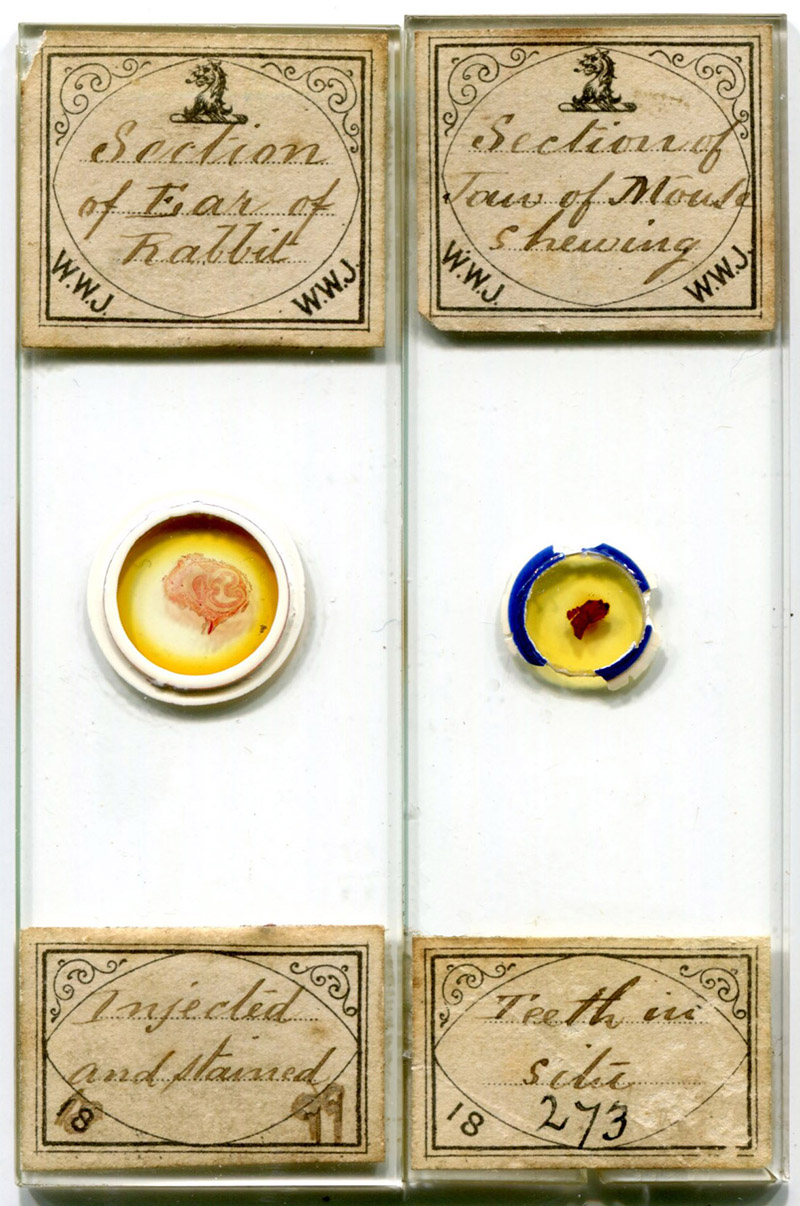
Figure 1. Microscope slides by W.W. Jones. The left slide was marked by him as having been made in 1877.
William Wansbrough Jones, 1853 - 1930
slide-maker "W. W. J."
by Brian Stevenson
last updated March, 2020
W.W. Jones was an amateur slide-maker, active between ca. 1873 and 1881. His microscope slides carry attractive, custom-made labels with his initials, “W.W.J.” (Figure 1). All of his slides that are known to me contain anatomical specimens from humans and various other animals (Figures 2 and 3). This is consistent with him being a medical student and surgeon during his slide-making period.

Figure 1.
Microscope slides by W.W. Jones. The left slide was marked by him as having been made in 1877.
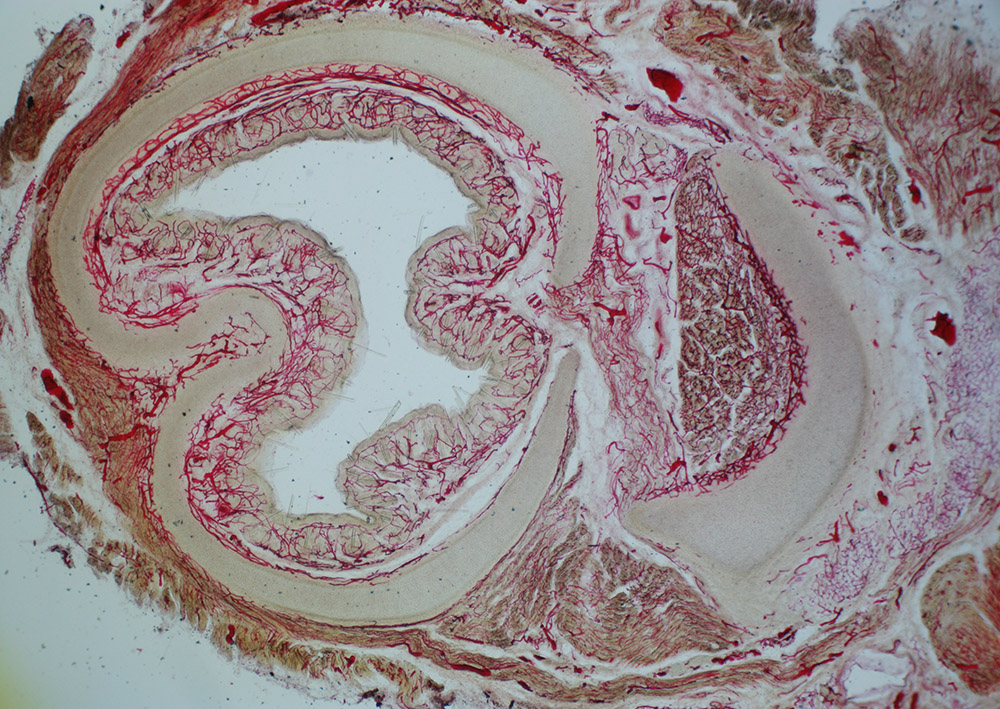
Figure 2.
“Section of ear of rabbit, injected and stained” by W.W. Jones, 1877 (see Figure 1). Presumably a cross section, with the dense, light-colored tissue being cartilage, and from a very young rabbit, considering the size. Photographed with a 3.5x objective lens and a C-mounted digital SLR camera.
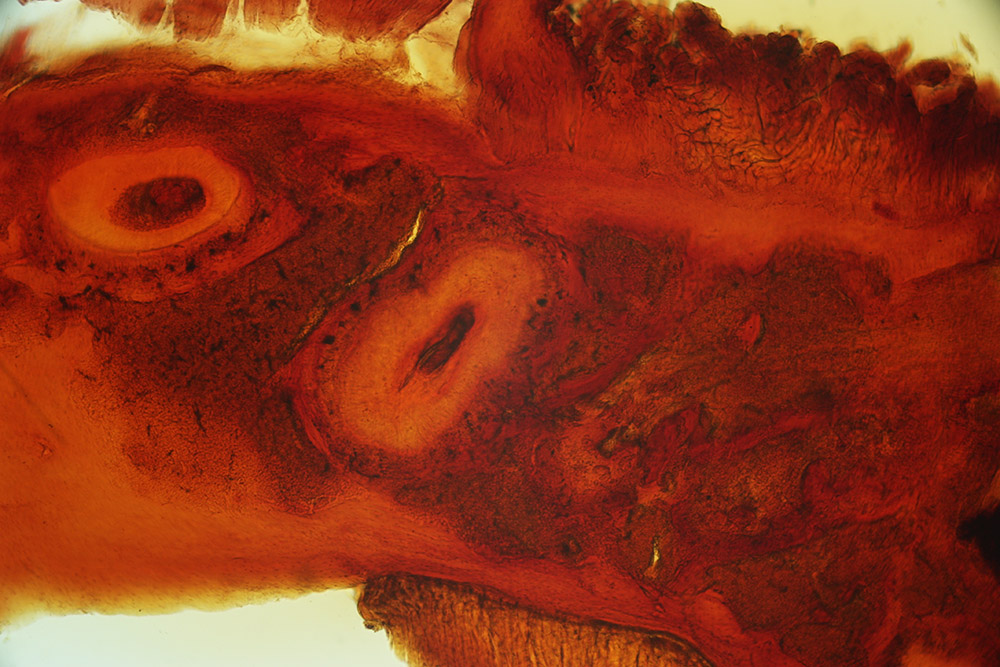
Figure 3.
“Section of jaw of mouse shewing teeth in situ”, by W.W. Jones (See Figure 1). Photographed with a 10x objective lens and a C-mounted digital SLR camera.
Microscope slides by W.W. Jones generally command high prices nowadays, due to their distinctive labels, quality preparation and finish, and their relative scarcity.
Tracking down the maker’s identity proved to be rather challenging. His slide labels provide only his initials as identification. But internet searches found that a person with initials “W.W.J.” had written to Hardwicke’s Science-Gossip in 1874; the end of each issue included a short section that states the initials of persons who had corresponded with the magazine during the previous month, but whose letters, etc. had not been printed because of space. Such correspondences were usually printed in the following month’s issue and, sure enough, the next issue included an offer to exchange microscope slides from “W.W. Jones”, of “14 Lancaster-street, Lancaster-gate, Hyde-park” (Figure 4). Further searches with that name and/or address revealed that W.W. Jones had published additional slide exchange requests. He joined the Quekett Microscopical Club on May 22, 1874 (Figure 4), and remained on the QMC’s membership rolls through 1881, always with the address of 14 Lancaster Street. During that time, Jones exhibited numerous slides to the QMC. Significantly, all references to Jones’ slides described them as mounts of anatomical tissues, corresponding with all known slides by “W.W.J.”.
The trail then ran cold. All records of Jones in the Journal of the Quekett Microscopical Club and Hardwicke’s Science-Gossip provided only his first and middle initials, never the full name. Searches of the 1871 and 1881 censuses revealed that nobody named Jones lived at 14 Lancaster Street during either of those times. The 1871 census listed Professor Edward Frankland, a chemist, as the head of household at 14 Lancaster Street. The 1876 Year-book of Pharmacy stated that Frankland still lived at that address. In 1879, The Chemist and Druggist reported that one John Richardson of 14 Lancaster Street, Hyde Park, had filed for bankruptcy. Since census records indicated that Richardson did not live at that address, this information suggested that Jones might also not have lived at 14 Lancaster Street, but instead worked for the chemists/pharmacists there. Internet searches for “WW Jones” combined with “chemist” or “pharmacy” did not reveal any useful results. Recalling the anatomical and histological specimens that Jones mounted, a search for “WW Jones” and “surgeon” hit pay dirt (Figure 5). Jones’ 1898 address in Didsbury, Lancashire led to his identification on the 1901 census, a first name, and a birth date. A cascade of information then led to this biography of slide-maker W.W. Jones:
William Wansbrough Jones was born on November 11, 1853, in St. Just, Cornwall. His father, John, was a Wesleyan minister. At the time of the 1861 census, the family lived in Brompton, Kent. William received education at New Kingswood School, Bath, and at Clifton College, Bristol. During the next national census, in 1871, William was working as an assistant school master at Grove Park Academy in Wrexham, Wales.
William received a demyship (half scholarship) to Magdalen College, Oxford University, and entered there in October, 1873. However, he received a B.Sc. degree from the University of London in 1875, and a Masters of Arts and Bachelor of Medicine from Oxford in 1877 (Figure 5). This implies that he spent a considerable amount of time in London prior to 1875. Jones’ first slide exchange offer appeared in Hardwicke’s Science-Gossip in late 1873, with the London address, suggesting that he probably lived to some extent at Frankland’s chemist shop. Being an aspiring physician/surgeon, Jones might have worked for the pharmacist.
Jones joined the QMC in May, 1874. In 1875, he made a presentation to the Club, “On an instrument for cleaning thin cover glass”. Jones’ device was clever enough that William Benjamin Carpenter described it in his The Microscope and Its Revelations, “On account of the extreme brittleness of the Thin-glass, it is desirable to keep the covers, when cut and sorted, in some fine and soft powder, such as Starch. Before using a cover, however, the Microscopist should be careful to clean it thoroughly; not merely for the sake of removing foulness which would interfere with the view of the object, but also for the sake of getting rid of adherent starch-grains, the presence of which might lead to wrong conclusions; and also to free the surface from that slight greasiness, which, by preventing it from being readily wetted by water, frequently occasions great inconvenience in the mounting of objects in fluid. The thicker pieces may be washed and wiped without much danger of fracture, if due care be employed; but the thinner require much precaution; and in cleansing these, a simple instrument devised by Mr. W.W. Jones will be found very useful. This consists of a small tube of brass about an inch in diameter and the same in height (a stout pill-box makes a good substitute), into which fits loosely a weighted plug, to the flat bottom of which is cemented a piece of chamois leather. Another piece of soft leather is stretched upon a fiat tablet of wood or plate-glass; and by placing the cover-glass (damped by the breath) under the plug, within the end of the tube, and keeping the tube well down on the tablet, the glass can be rubbed between the two leather surfaces with perfect security, the weight of the plug affording sufficient pressure”. Carpenter also noted that Jones’ innovation had been adopted by a commercial manufacturer, “In the improved form of this little instrument made by Messrs. Hunter and Sands, the leather is not cemented to the bottom of the plug, but merely strained over it, so as to be easily renewable”.
In August, 1875, William Jones passed the “B.Sc. and Preliminary Scientific Examinations” at the University of London.
In 1877, William Jones entered his first year of medical training at St. Thomas’ Hospital, London.
He was awarded a fellowship from Oxford in 1880. This was announced as “The Radcliffe Travelling Fellowship in the University of Oxford has been awarded to Mr. William Wansbrough Jones, B.A. Oxon., B.Sc. Lond., student of St. Thomas's Hospital. Mr. Jones was educated at New Kingswood School, Bath, and Clifton College, and was elected to a Demyship at Magdalen College, Oxford, in October, 1873. He graduated in first class honours in the School of Natural Science, in June, 1876, and has since gained several scholarships and prizes at St. Thomas’s”.
The 1881 national census was conducted in the spring of 1881, shortly before Jones completed his medical training. At that time, he was lodging at a house in Lambeth, London. However, he was still using the Hyde Park address with the QMC.
Jones graduated from St. Thomas’ in 1881. He was not listed in the 1882 membership roster of the QMC. No records have been found of W.W. Jones being involved with microscopy after that time.
He probably moved to the Didsbury, Lancashire area after graduating from medical school. Although I have not located their marriage record, William married a woman named Catherine (Kate) from that area, and the pair had a son in 1890. The 1891 census recorded William, Kate, and their son, also named William Wansbrough Jones, living with the support of two house maids. Young William did not survive his first year. A second son, Arthur Wansborough Jones, was born during the summer of 1891. A daughter, Gwendolyn, was born in about 1905.
The Jones family emigrated to North America in 1910. William appears to have gone first, and initially settled in New York state. Son Arthur arrived in Quebec on August 4, 1910, headed for Kelowna, British Columbia to become a “fruit grower”. Wife Kate and daughter Gwendolyn arrived in Quebec on October 13, with a stated destination of New York, evidently to meet William.
The 1921 census of Canada recorded that William and Katherine Jones were living at the Okanaga Mission, near Kelowna. William was then a “retired medical practitioner”. Presumably, he had earlier served as medical doctor to the area’s residents. William died on January 7, 1930, in Okanaga.
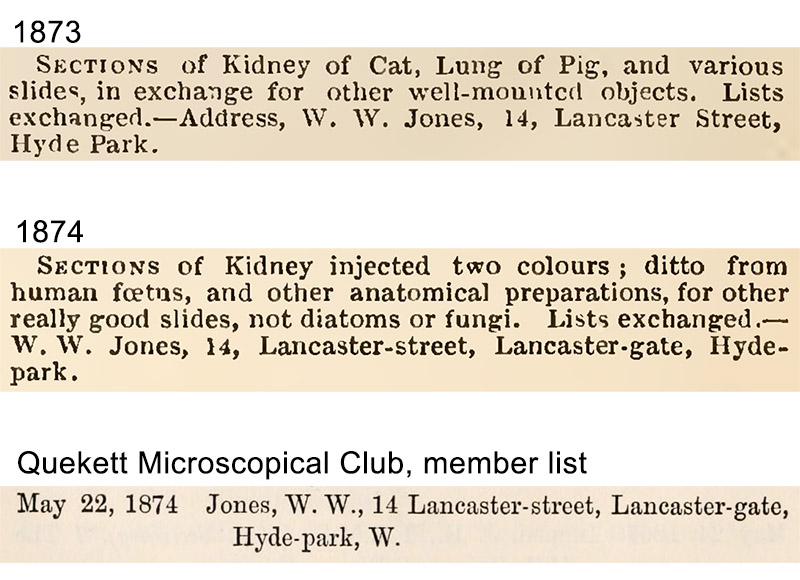
Figure 4.
Some records of W.W. Jones’ involvement in microscopy: 1873 and 1874 exchange offers from the popular science magazine “Hardwicke’s Science-Gossip”, and information from “The Journal of the Quekett Microscopical Club” that Jones joined the QMC in 1874.
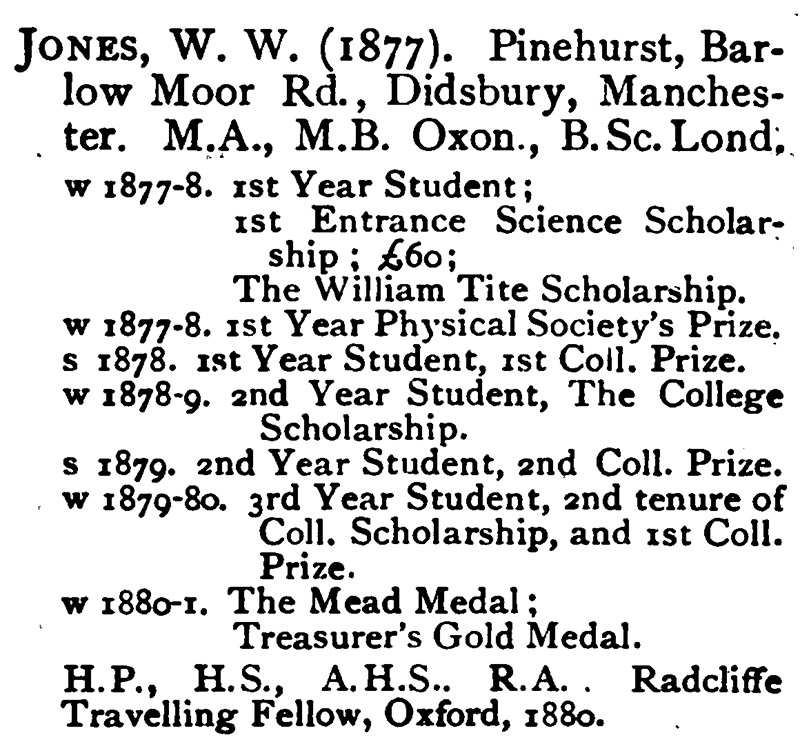
Figure 5.
Information on Jones’ education at St. Thomas’ Hospital, London, which coincided with the dates that he is known to have been an amateur microscopist in London. From the 1898 “St. Thomas’ Hospital Reports”.
Resources
British Medical Journal (1880) Announcement of the award of the Radcliffe Travelling Fellowship to William W. Jones, page 461
Canada census and other records, accessed through ancestry.com
Carpenter, William Benjamin (1881) The Microscope and Its Revelations, Sixth edition, J. & A. Churchill, London, page 211
Chemical News and Journal of Industrial Science (1875) “University of London - The following are lists of the candidates who have passed the recent B.Sc. and Preliminary Scientific Examinations: … W. W. Jones, Magdalen College, Oxford”, Vol. 32, page 85
Chemist and Druggist (1879) “Liquidations: … Richardson, John, 14 Lancaster Street, Hyde Park, and 88 Pimlico Road, Chelsea, baker, trading as Field & Co., at 267 High Holborn, druggist. late 53 Brompton Road, and 58 Rawlings Street, Chelsea, and 21 and 17 Charing Cross, baker”, Vol.21, page 256
England census and other records, accessed through ancestry.com
Hardwicke’s Science-Gossip (1873) Advertisement from W.W. Jones, Vol. 9, page 96
Hardwicke’s Science-Gossip (1874) Advertisement from W.W. Jones, Vol. 10, page 96
Jones, W.W. (1875) On an instrument for cleaning thin cover glass, Journal of the Quekett Microscopical Club, Vol. 4, page 49
Journal of the Quekett Microscopical Club (1874) List of members, “May 22, 1874 Jones, W. W., 14 Lancaster-street, Lancaster-gate, Hyde-park, W.“
Journal of the Quekett Microscopical Club (1877) December 14 Conversational Meeting. “the following objects were exhibited … Injected sections of Guinea-pig, Mr. W.W. Jones”, Vol. 5, page 24
Probate of the will of W.W. Jones (1930) “Jones William Wansbrough of The Firs Okanagan Mission British Columbia Canada died 7 January 1930 Probate Kelowna to Arthur Wansbrough Jones and Kate Wansbrough Jones. Effects £1446 16s 11d in England. Sealed London 18 June”, accessed through ancestry.com
St. Thomas's Hospital Reports (1898) Jones, W.W., Vol. 26, page 97
Tilden, William Augustus (1921) Frankland, in Famous Chemists: The Men and Their Work, Routledge, London, pages 216-227
Year-book of Pharmacy (1876) “Frankland, Prof. E., D.C.L., F.B.S., 14, Lancaster Gate, Hyde Park, W.”, page 400